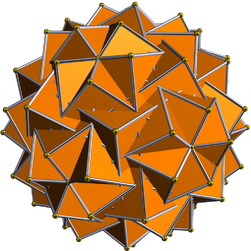Great hexagonal hexecontahedron
Appearance
| Great hexagonal hexecontahedron | |
|---|---|

| |
| Type | Star polyhedron |
| Face | 
|
| Elements | F = 60, E = 180 V = 104 (χ = −16) |
| Symmetry group | I, [5,3]+, 532 |
| Index references | DU64 |
| dual polyhedron | Great snub dodecicosidodecahedron |

In geometry, the great hexagonal hexecontahedron (or great astroid ditriacontahedron) is a nonconvex isohedral polyhedron. It is the dual of the uniform great snub dodecicosidodecahedron. It is partially degenerate, having coincident vertices, as its dual has coplanar pentagrammic faces.
Proportions[edit]
The faces are nonconvex hexagons. Denoting the golden ratio by , the hexagons have one angle of , one of , and four angles of . They have two long edges, two of medium length and two short ones. If the long edges have length , the medium ones have length and the short ones . The dihedral angle equals .
References[edit]
- Wenninger, Magnus (1983), Dual Models, Cambridge University Press, ISBN 978-0-521-54325-5, MR 0730208







